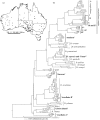Cryptic diversity in vertebrates: molecular data double estimates of species diversity in a radiation of Australian lizards (Diplodactylus, Gekkota)
- PMID: 19324781
- PMCID: PMC2677245
- DOI: 10.1098/rspb.2008.1881
Cryptic diversity in vertebrates: molecular data double estimates of species diversity in a radiation of Australian lizards (Diplodactylus, Gekkota)
Abstract
A major problem for biodiversity conservation and management is that a significant portion of species diversity remains undocumented (the 'taxonomic impediment'). This problem is widely acknowledged to be dire among invertebrates and in developing countries; here, we demonstrate that it can be acute even in conspicuous animals (reptiles) and in developed nations (Australia). A survey of mtDNA, allozyme and chromosomal variation in the Australian gecko, genus Diplodactylus, increases overall species diversity estimates from 13 to 29. Four nominal species each actually represent multi-species complexes; three of these species complexes are not even monophyletic. The high proportion of cryptic species discovered emphasizes the importance of continuing detailed assessments of species diversity, even in apparently well-known taxa from industrialized countries.
Figures

References
-
- Adams M., Baverstock P.R., Watts C.H.S., Reardon T. Electrophoretic resolution of species boundaries in Australian Microchiroptera. I. Eptesicus (Chiroptera, Vespertilionidae) Aust. J. Biol. Sci. 1987;40:143–162.
-
- Altekar G., Dwarkadas S., Huelsenbeck J.P., Ronquist F. Parallel metropolis coupled Markov chain Monte Carlo for Bayesian phylogenetic inference. Bioinformatics. 2004;20:407–415. doi:10.1093/bioinformatics/btg427 - DOI - PubMed
-
- Aplin K.P., Adams M. New species of gekkonid and scincid lizards (Squamata) from the Carnarvon Basin region of Western Australia: morphological and genetic studies of ‘cryptic species’. J. R. Soc. West. Aust. 1998;81:201–204.
-
- Bostock B.M., Adams M., Laurenson L.J.B., Austin C.M. The molecular systematics of Leiopotherapon unicolor (Gunther, 1859): testing for cryptic speciation in Australia's most widespread freshwater fish. Biol. J. Linn. Soc. 2006;87:537–552. doi:10.1111/j.1095-8312.2006.00587.x - DOI
-
- Bustard H.R. Temperature dependent activity in the Australian gecko Diplodactylus vittatus. Copeia. 1968;3:606–612. doi:10.2307/1442032 - DOI
Publication types
MeSH terms
Substances
LinkOut - more resources
Full Text Sources

